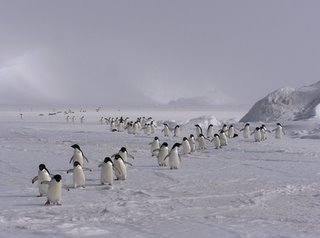Antarctic Fog
I'm back after a month of too much work, sporadic Internet (bad weather in December, which caused our solar panels to take in too little power), and a constant desire to be outside...

Grant walking in the fog
In early December we had a small storm - small by Crozier standards, with winds to 80mph - that blew away the apparently essential white plastic tube that covered our wireless antenna. A few days later Grant and I decided to go look for it out on the ice. We figured that, given the predominantly southerly winds, the tube must have blown along the kilometer-long snow field downhill and downwind of the hut and that it was either resting in the folds of some sastrugi (wind-carved snow) or lying on the fast ice (sea ice attached to the shoreline) at the bottom of the snow slope. The sky was clear and the hut was in full sun, but as we descended the slope we entered into a thick blanket of fog that lay low over the cold ocean. Our search suddenly turned from hopeful to mostly meditative, since the prospects of finding a white object on a white surface in the flat light of a dense fog bank are rather minimal. But I trudged on, marveling at the fact that Grant had totally vanished from my sight despite the fact that he was but 100m from me. He blurred in and out of view as he wove his way down the slope on this unlikely search. When we reached the bottom we stepped onto the frozen ocean with it hard, jagged, snow-covered surface keeping us from slipping on the blue ice beneath. A few hundred meters ahead lay several grounded tabular (flat-topped) icebergs. They formed a citadel in various stages of decay - ice deconstructed by wind and rearranged by the movements of larger bergs that occasionally collide with the coast, with deep gashes revealing ice's inner blue secrets. Here the fog was denser but lay in patches from which the citadel emerged. The light and the iceberg backdrop made it look like a stage in some kind of celestial theater. Then I noticed the penguins. There were hundreds of them on the fast ice heading back to the colony. They were arranged in a jagged single file and they called and grunted as they went along, some walking and some tobogganing on their bellies, using their feet to push themselves along and their flippers to steer and maintain balance. They were mostly males who had taken the first incubation shift after egg-laying, had gone out to sea on their first foraging trip, and were returning to their nests to relieve their mates once again. I sat down and watched them file by, not daring to cross their line to keep following the plastic tube's imaginary, wind-borne path, which at this point had taken on a secondary importance. Grant walked through a gap in the penguin line and continued looking for the tube in the ice folds at the foot of the citadel. I waited for another gap, crossed, and then followed the birds to the western end of the colony, where they finally fanned out as they headed for their respective nests.

Ice and penguins emerging from the fog

Adelies walking along the fast ice...

...and walking along the citadel towards the colony.

0 Comments:
Post a Comment
<< Home